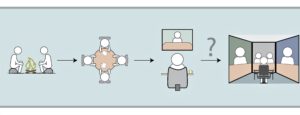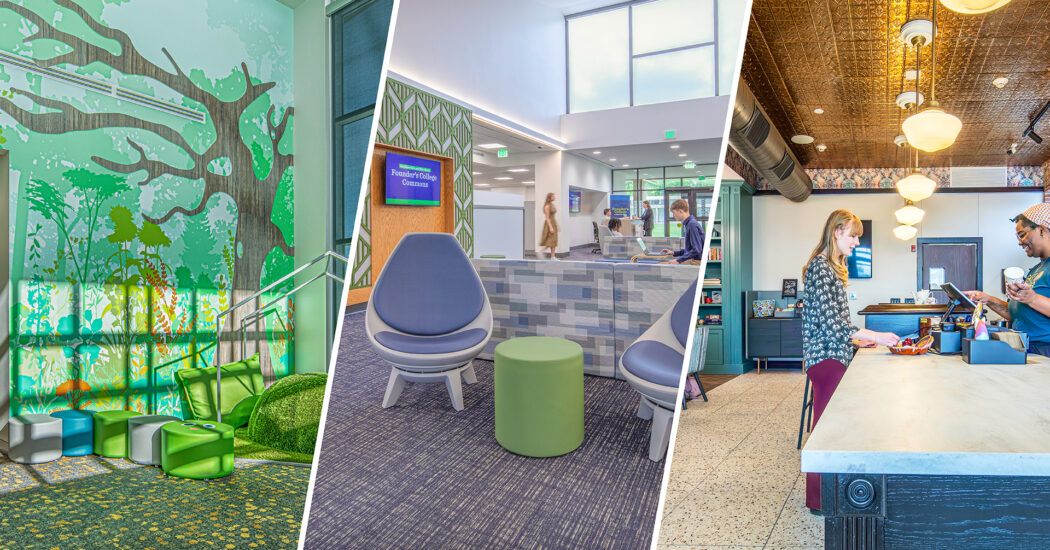The Evolution of a Meeting
-
Category
Studio-Workplace, Studio-K12, Studio-Higher Ed, Innovation -
Posted By
Eddie Layton -
Posted On
Feb 07, 2017
Since the beginning of social civilization, people have held meetings in some form or another. One could argue the first “meetings” were held around a campfire, discussing a tribes’ plans for the next season and where they would move. Over time, as humans settled and formed cities, these meetings moved into a room. The technological revolution of the past 60 years however, has had a drastic impact on how humans meet and interact inside and outside of these rooms.

FROM THE PAST TO THE FUTURE
Technology has been one of the biggest driving forces behind change in our society. It is evident when looking back throughout history and when looking ahead to the future. From the health field to the design world, and into people’s everyday lives, evolving technology has made a huge impact: one way or another. It changes the way we learn, communicate, work, and play. There is less face-to-face interaction and more face-to-screen conversations today. Anyone who walks down a busy street and counts how many people are looking at their smartphones could attest to this.
This face-to-screen aspect has a significant impact on how we design spaces. We’ve noticed a trend across all project types, particularly workplace and education. There is a want/need for specific technology to allow for some form of virtual meetings. Video conferences, instant messaging, screen sharing, and note transfers are just a few non-traditional meeting options technologies now brings to the table. Like anything else, there will always be advantages and disadvantages to these digital meetings:
Pros
- Saves time and money on travel. Between traveling costs, mileage, and possibly even hotels, a simple long-distance meeting can rack up big bucks and take hours. Technology allows businesses and schools to put that money toward something else on the list because they saved money on travel.
- Your geographical range can expand. It is a lot simpler to meet with someone across the world if you just tap in via video conferences. Even if there is a 12-hour time difference. One less reason to hold back on expansions for your business.
- Everyone can feel connected. Whether it is connecting long-distance employees/clients to a project more directly or allowing a sick student to conference into class instead of missing out on a lesson, using technology has a way of bringing people together to make them feel included.
- Meetings can happen more frequently. Due to the costs of travelling, meetings would often be more sporadic and for longer periods of time. Now, you can hold a standing weekly hour-long meeting with individuals all around the world rather than traveling to one meeting every six.
Cons
- Can be hard to read the people on the other end. Not everyone is set up with capabilities to video conference in. This makes it impossible to read body language and make direct eye contact.
- It is expensive! It isn’t a secret that high-tech comes with a high price tag.
- There can always be glitches that come along with technology. Jumping on an important conference call 20 minutes late because your conferencing system was having a technical problem can be frustrating.
In the past, there have been many design solutions to attempt to overcome these cons, and bring us back to the human interaction that started with that first meeting around a campfire. Several companies have developed possible solutions that were specifically designed to counter-act the inherent disconnect of looking at someone on a screen rather than physically sitting across the table from them. These “telepresence” rooms often try to recreate an in-person meeting room, through a variety of visual gimmicks such as curved tables or half of a table with a screen at the end, but these often fall flat. Furthermore, with fixed furniture, there is not much of an option to use this room for anything other than virtual meetings.
With the development of larger, thinner, and higher resolution display screens, we are approaching a time that has often been the subject of science fiction movies: wall surfaces become virtual displays, 360-degree virtual reality cameras recreating any location, holograms, etc. It does not seem like such a far-fetched idea now that you could have multiple people meeting in a “virtual” conference room, looking at the person on a screen as if they are sitting next to you. The flexibility of not being tied to a specific piece of furniture or specific set of technology frees the end user to use this room in a multiple of ways.
The biggest hurdle to this is going to be the cost and continuous development always spitting out the next “big thing”. However, designing around an idea rather than a specific product could help alleviate some concerns, so new technology could be swapped into an existing room without a complete redesign. There is no perfect answer at this point to making the virtual meeting as effective as those first “meetings” around a campfire from the human perspective, but change is coming. And with each new development, we step incrementally closer to achieving that goal.







